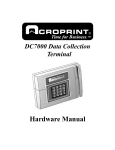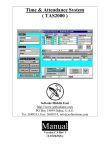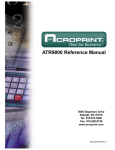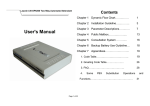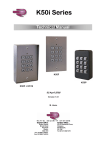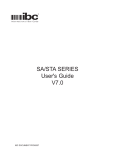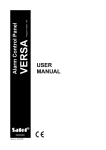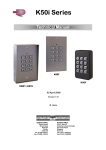Download Acroprint Acrocomm program Hardware manual
Transcript
Data Collection Terminal 0 -10-0 M 04 A 8:20 QZ. 1 GHI 4 PRS 7 IN ABC 2 JKL 5 TUV 8 -SP 0 DEF 3 MNO 6 WXY 9 OUT AR CLE K BAC E C SPA HA ALP ER ENT HARDWARE MANUAL FCC Warning: Note: This equipment has been tested and found to comply with the limits for a Class A digital device, pursuant to Part 15 of the FCC rules. These limits are designed to provide reasonable protection against harmful interference when the equipment is operated in a commercial environment. The equipment generates, uses, and can radiate radio frequency energy. If not installed and used in accordance with the instruction manual, it may cause interference with the radio and television reception in a residential area, in which case the user will be required to correct the interference at his or her own expense. If this equipment causes interference, try to correct the problem by: Reorienting the receiving antenna. Relocating the terminal with respect to the receiver with which it interferes. Plugging the terminal into a different AC outlet, and putting the terminal and receiver on different branch circuits. FCC Compliance: (on hardware equipped with modem) This equipment complies with Part 68 of FCC Rules. Upon request, furnish the following information to the telephone company (telco). Manufacturer: Acroprint Time Recorder Co., Inc. Model: Badger II Terminal FCC registration number: 4G3USA-21602-DT-E Ringer equivalence: 0.7B USOC modular telephone jack: R-J11 Lithium Battery Caution: This circuit board on this terminal is populated with a lithium battery to protect data or programs stored in the Random Access Memory (RAM). Do not, under any circumstances, attempt to replace the lithium battery in the terminal. Failure to comply may invalidate your warranty. Battery replacement should be done by qualified personnel wearing the proper eye protection. CAUTION: Danger of explosion if battery is incorrectly replaced. Replace only with the same or equivalent type recommended by the manufacturer. Discard used batteries according to the manufacturers instruction. Declaration Of Conformity According To EMC Directive 89/336/EEC We declare under our sole responsibility that the magnetic stripe and/or bar code reading and/or data recording equipment Badger II 01-0119-000/003/ 005/007 to which this declaration relates are in conformity with the following standards: EN55022:1987, EN50082-1, IEC 801-2, IEC 801-3, IEC 801-4, IEC 801-5. I, the undersigned, hereby declare that the equipment specified above conforms to the above directive and standards. Raleigh, North Carolina October 7, 2002 USA All Rights Reserved. © COPYRIGHT 1996 Acroprint Time Recorder Company 2 W. Glenn Robbins Table of Contents 1. Introduction ................................................................. 4 Basic hardware and variations ................................................ 4 General specifications ............................................................. 5 2. Setup ............................................................................ 6 Site requirements .................................................................... 6 Unpacking and inspection ...................................................... 6 Mounting ................................................................................ 7 Power up ................................................................................. 7 3. Operator interface ....................................................... 8 ADCT Keypad ........................................................................ 8 DataLog Keypad ..................................................................... 8 Card reader ............................................................................. 9 4. Ports and connections ............................................. 10 Acroprint Data Collection Terminal setup instructions ........ 10 Ethernet port ......................................................................... 13 RS-232 Serial port ................................................................ 14 RS-232 Serial printer cables ................................................... 15 Local Area Network: RS-485 serial port .............................. 16 RS-485 Serial cables ............................................................. 17 Modem port .......................................................................... 18 Modem cables ....................................................................... 19 Wand port ............................................................................. 20 Wand and Y-Cable ................................................................ 21 Parallel port........................................................................... 22 Parallel cable ......................................................................... 23 5. Companion products ................................................ 24 Printer ................................................................................... 24 Readers ................................................................................. 24 Power Supplies ..................................................................... 25 External Relay Box, External Buzzer ................................... 25 Cables ................................................................................... 26 Cables, Converter, Badge Racks........................................... 27 Table of Contents 3 1. Introduction Basic hardware and variations The electronic hardware is a new, versatile platform designed for use with various applications. This manual describes, in detail, the electronic hardware aspects of the terminal you have purchased. The details concerning terminal firmware and host software are addressed in the manual which comes with the software. All terminals are equipped with: 1) a magnetic stripe reading head 2) a 2 row x 20 character per row display 3) a 16-key full travel keypad 4) an RS-232 serial port 5) a wand port for optional bar code wand 6) two control lines for external relay control (door access, and bell ringer are typical applications) 7) a 25-pin parallel port The terminal is offered in different hardware variations. Listed below are the variations by part number and description: Part # Description C - Programmable e-prom (DataLog) 01-0120-000 DataLog with LAN (RS-485) 01-0120-002 DataLog with Modem (no LAN) 01-0120-003 DataLog with LAN & Internal Visible Bar Code Reader 01-0120-004 DataLog with Modem & Internal Visible Bar Code Reader 01-0120-005 DataLog with LAN & Internal Infrared Bar Code Reader 01-0120-006 DataLog with Modem & Internal Infrared Bar Code Reader 01-0120-008 DataLog with Ethernet 01-0120-010 DataLog with Ethernet & Internal Visible Bar Code Reader 01-0120-012 DataLog with Ethernet & Infrared Bar Code Reader Acrocomm e-prom (Acroprint Data Collection Terminal ADCT) 01-0147-000 Acroprint with LAN (RS-485) 01-0147-002 Acroprint with Modem (no LAN) 01-0147-003 Acroprint with LAN & Internal Visible Bar Code Reader 01-0147-004 Acroprint with Modem & Internal Visible Bar Code Reader 01-0147-005 Acroprint with LAN & Internal Infrared Bar Code Reader 01-0147-006 Acroprint with Modem & Internal Infrared Bar Code Reader 01-0147-008 Acroprint with Ethernet 01-0147-010 Acroprint with Ethernet & Internal Visible Bar Code Reader 01-0147-012 Acroprint with Ethernet & Infrared Bar Code Reader Note: The part number of your unit can be found on the serial number label on the back of the terminal. 4 Introduction General specifications A. Enclosure: 8.7 in. (23 cm) wide x 6.1 in. (16 cm) tall x 2.3 in. (6 cm) deep. Clamshell construction of 0.125 in. (3 mm) thick Polycarbonate/ABS injection molded flame retardant plastic. Includes reversible mounting bracket and access door which protects I/O ports. B. Multilayer main logic board with internal ground and power planes. C. Z-180 Microprocessor. D. Up to 512 Kbyte configurable memory. Most common configuration is 64K ROM and 128K RAM. E. Lithium battery backed RAM. F. Real Time Clock Chip on-board. G. Magnetic card reader: Track 2 ABA recording head for reading standard Credit Card format through the slot. H. Display: 2 lines with 20 characters on each line. ADCT is backlit. I. Keypad: Full travel keys with elastomeric contact pad, 4 rows x 4 columns. J. Serial Port: RS-232 using 6 position (4 contact) RJ-11 modular connection. K. Serial Port: RS-485 (Local Area Network) using RJ-11 modular connection. L. Parallel port: 25-pin DB connection. M. Internal Modem: Bell 212A (1200bps) and 103 (300bps) , CCITT V.22 bis (2400 bps) and V.22 (1200 bps), asynchronous, licensed for use over public telephone lines. N. Internal Multi-Frequency Piezo Electric Buzzer. O. Internal Bar Code Reader: Visible or Infrared Bar Code reading through the slot. P. Control lines: Two pins of the 6-pin circular DIN connector can be used with external relay box to control devices such as door locks and bells. Q. External Bar Code port: 6-pin DIN connection for external Bar Code Wand or Bar Code Gun. R. Power: Wall mount transformer, 9 Volts AC/DC 800 mA minimum or 10 Volts AC/DC 700 mA minimum, with female secondary plug size 2.1 x 5.5 mm. Introduction 5 2. Setup Site requirements The terminal can be installed in any normal office or controlled factory environment. However, do not use the terminal under the following conditions: extremely high or low temperature [operating temperature range: 0° to 50° C (32° to 122° F)] [storage temperature range: -20° to 60° C (-4° to 140° F)] extremely high or low humidity [operating humidity range : 0 to 90% RH non-condensing] areas of high dust concentration areas with chemical fume concentration areas with extreme vibration or when placed on an unstable or unlevel surface Unpacking and inspection Having opened the shipping carton, carefully remove the contents. Inspect the terminal and accessories for damage. Report damage or shortages to the company from which the unit was purchased. Complete the registration card with all important information. 8:20 -10-00 AM 04 QZ. 1 GHI 4 PRS 7 IN ABC 2 JKL 5 TUV 8 -SP 0 DEF 3 MNO 6 AR CLE BACK CE SPA HA WXY 9 ALP OUT ENT ER (1) Terminal (1) Power Supply Data Collection Terminal 8:20 10-00 AM 04- QZ. 1 GHI 4 PRS 7 IN ABC 2 JKL 5 TUV 8 -SP 0 DEF 3 MNO 6 WXY 9 OUT CLEAR BACK SPACE ALPHA ENTER HARDWARE MANUAL (4) Mounting Screws 6 Setup (1) Manual Mounting Unscrew the access door. With the door off, the main unit can be slid upward and removed from the mounting bracket. The bracket can be used for wall mounting, or it can be reversed to tilt the unit on a desktop. Power up Plug in the power cord coming from the wall mount transformer into the terminal. Reattach the access door and secure the unit to the reversible bracket. Replace screw on the access door. NOTE: Other connections are made in the same fashion. Notice the channels in the bracket available for cable routing. Also, the bracket has through-holes for further securing of cables using ties. Setup 7 3. Operator interface ADCT Keypad The terminal has 16 keys for entering alphabetical and numeric data as illustrated below. QZ. 1 ABC 2 DEF 3 CLEAR GHI 4 JKL 5 MNO 6 BACK SPACE PRS 7 TUV 8 WXY 9 ALPHA IN -SP 0 OUT ENTER DataLog Keypad The terminal has 16 keys for entering data as illustrated below. 1 4 7 8 Operator interface 2 5 3 6 8 0 9 CLEAR MENU MENU ENTER Card reader The terminal has an internal magnetic stripe card reader. The magnetic stripe on the card should be on the right side when the card is swiped as shown below. Bar Code - left side Magnetic stripe right side 0.25" Nominal Optionally, the terminal can also have an internal bar code reader. The card is swiped through in the same fashion, but the Bar Code should be on the left side of the card when swiped. 1.00" Min. NOTE: For through-the-slot reading, Bar Code should be located on card as shown. Operator interface 9 4. Ports and connections Acroprint Data Collection Terminal setup instructions Configuring procedure for entering the DATE & TIME: Swipe the Configuration Badge 000000000 (This badge is provided with each terminal) Select option 1 for DATE <Press ENTER> Select the Day, Month, Year DDMMYYYY <Press ENTER> Select the Time HH:MM <Press ENTER> (Time is entered in military time, 2:00 pm = 14:00) Configuring procedure for selecting PORTS: Swipe the Configuration Badge 000000000 (This badge is provided with each terminal.) Select option 2 for Ports <press ENTER> Select option 0 for RS232 <press ENTER> Select the baud rate 0 for 1200, 1 for 2400, 2 for 4800, 3 for 9600 and 4 for 19,200 baud. <press ENTER> (For modem terminal only) Select option 1 for Modem <press ENTER> Select the Modem baud rate 0 for 1200 and 1 for 2400 baud <press ENTER> Select the Answer Window HHMMHHMM for starting and ending times <press ENTER> (time is in military format, Example: Clock will not answer during business hours and only answer between the hours of 8:00 pm and 6:00 am, then select 20000600.) 10 Ports and connections (For RS485 terminals only) Select option 1 for RS485 <press ENTER> Select the baud rate 0 for 1200, 1 for 2400, 2 for 4800, 3 for 9600 and 4 for 19,200 baud. <press ENTER> (For Ethernet terminals with ATR9800 only) Select option 2 for Ethernet <press ENTER> Select the baud rate option 3 for 9600 baud <press ENTER> (Leave this as the default for Ethernet.) Select the TCPIP address <press ENTER> (Your network administrator will have this information.) Select the GATEWAY address <press ENTER> (Your network administrator will have this information.) Select the PORT VALUE <press ENTER> (Default number 10001. Select the same value in the ATR9800 software.) Select the NETMASK VALUE <press ENTER> (Your network administrator will obtain this information. The Network SubNetMask TCPIP number contains 4 elements of numbers separated by .. To determine the NETMASK VALUE obtain your Network SubnetMask IP number from the Network administrator, i.e. XXX.255.255.000. Convert the last three elements (your numbers will be different) to binary and count the total number of zeros in each binary element and enter this number. 255 = 11111111 in binary, 000 = 00000000. Each 255 contains NO zeros therefore the Netmask value bits number is set to 08 for the example XXX.255.255.000.) The Ethernet terminal Netmask values can range from 01 to 24. Select the TERMINAL TRANSACTION PRINTER TYPE <press ENTER> (default is parallel port) Ports and connections 11 Select TRANSACTION TIME OUT <press ENTER> (This controls how long the terminal will restrict between badge swipes. Example: You want to keep your employees off the terminal for at least 30 minutes for lunch, then set Transaction Time Out to 30.) Select TERMINAL ID <press ENTER> (default is 1, select the ID for terminal, each terminal MUST have a unique ID) The terminal MUST be powered down and back up to accept the new TCPIP information. Configuring procedure for selecting the READERS: Swipe the Configuration Badge 000000000 (This badge is provided with each terminal.) (Select any combination 1234 to activate the readers. 1 for Internal Barcode, 2 for External Barcode, 3 for Internal Magnetic Stripe and 4 for Internal Proximity Reader) Note, if 4 is selected then the External Barcode Reader will be disabled. Note, if you turned OFF all readers you will be unable to read the configuration badge. The following procedure will allow you to re-enable the readers. Press the IN, then the OUT and then the ENTER key within 1 second. The terminal will go into a testing mode. Press the Clear key, press the IN key, then the OUT key and then the ENTER key within 1 second or before the time is displayed. 12 Ports and connections Ethernet port The Ethernet port is located on the lower left corner of the terminal. It is a 10 position 8-pin female port which will accept a male 10BASE-T (RJ-45) modular connector. The terminal has the capability to communicate across an intranet, a WAN or the Internet. Note: Ethernet communicates via TCPIP 10BASE-T only. ND WA RS 485 RS 232 9V Ports and connections 13 RS-232 Serial port The RS-232 serial port is located on the lower left corner of the terminal. It is a 6 position 4-pin female port which will accept a male RJ-11 modular connector. ND WA RS 485 The Acroprint Data Collection Terminal can use RS-232 serial communication to connect directly to a host computer. A connection for an IBM PC or compatible is shown below. RS 232 9V Cabling to Host Computer with DB-25 Port (Use DB-25 RS-232 Host Cable Assembly. See page 26.) DB-25 to RJ-11 Adaptor (Adaptor A) "Standard" Modular Cable Schematic NOTE: Schematic connections are shown from END VIEW. (As viewed from the outside of the connectors.) Schematic Cabling to Host Computer with DB-9 Port (Use DB-9 RS-232 Host Cable Assembly. See page 27.) DB-9 to RJ-11 Adaptor (Adaptor A) "Standard" Modular Cable Schematic NOTE: Schematic connections are shown from END VIEW. (As viewed from the outside of the connectors.) 14 Ports and connections Schematic RS-232 Serial printer cables The terminal serial port is used for connection to a serial printer. Printers, such as the serial printer shown on page 24, use a circular DIN connection. The Serial DIN Cable is shown below (see page 26). Cabling to serial printer with 6-pin DIN port DIN connector 72-0158-002 Serial DIN Cable Schematic NOTE: Schematic connections are shown from END VIEW. (As viewed from the outside of the connectors.) Ports and connections 15 Local Area Network: RS-485 serial port The RS-485 serial port is located on the lower left corner of the terminal. It is a 6 position 4-pin female port which will accept a male RJ-11 modular connector. ND WA RS 485 RS 232 9V The terminal can use RS-485 2-wire serial communication, allowing up to 32 terminals to be connected to one host port. An RS-232 port on the host is typically used in conjunction with an RS-232/RS-485 converter to complete the connection. Through software, the host can communicate with individual terminals even though they are wired in parallel. RS-485 communication uses a differential bus which provides good protection from interference over long runs of up to 4000 feet. NOTE: When wiring a network, always follow the electric wiring codes in your area. Typically, a teflon coated wire is required for wiring through the ceiling. The junction box to junction box wire shown on the opposite page is a teflon jacketed cable. 16 Ports and connections RS-485 Serial cables Junction Box Daisy Chain Wiring Diagram 4 5 + + + 3 + 4 2 5 + + + 3 + 4 2 5 Junction Box To another Junction Box + + + 3 + 2 Junction Box Teflon Cable Junction Box To terminal (short as possible) "Standard" Modular Cable "Reversed" Modular Cable Schematic Schematic DB-25 to RJ-11 Adaptor (Adaptor C) Schematic NOTE: Connectors are shown from END VIEW. (As viewed from the outside of the connectors.) RS-232 to RS-485 Converter To serial port on host computer Ports and connections 17 Modem port Terminals which are equipped with a MODEM port, will not have an RS-485 port. The MODEM port, when installed, physically replaces the RS-485 port and occupies the same location - the lower left corner of the badge terminal. It is a 6 position 4-pin female port which will accept a male RJ-11 modular connector. ND WA RS 4MO8D5EM RS 232 9V The internal modem (modulator/demodulator) converts electronic data into tones which are then transmitted over phone lines. The modem is compatible with Bell 103/212A and CCITT V.21/V.22 devices. It supports both asynchronous and synchronous (SDLC) communication and can communicate with a host computer over phone lines at 300, 1200, and 2400 baud. 18 Ports and connections Modem cables The cabling for modem operation is typically very simple. The modular connection uses the two inner wires of the RJ-11 jack for tip and ring. Connect one end of the cable to the terminal and plug the other end into your RJ-11 type modular telephone wall jack. If a modular wall jack is not available, obtain an adaptor from your local telephone company. “Standard” Modular Cable Schematic Ports and connections 19 Wand port The Wand port is located on the lower left corner of the terminal. It is a 6-pin DIN port which will accept a circular DIN connector. ND WA RS 485 RS 232 9V The Wand, when connected, uses only 3 of the 6 pins available on the DIN connection. If a Bar Code Gun (non-contact reader) is used, the center pin supplies additional power. The terminal uses 2 of the remaining pins as logic lines for external controls. See pin-out and function table below: Pin 1 2 3 4 5 6 Function 6 1 +5 Volts 5 Signal control logic line (special) Bar Code Wand receive data 2 GND 4 3 Access logic line (special) END VIEW 9 Volt unregulated 6-pin DIN jack (maximum current draw 220 mA) 20 Ports and connections Wand and Y-Cable Disconnect power to the terminal before connecting the Bar Code Wand. The wand is capable of reading bar code stripes by passing it directly over the label. Check the software manual to identify the codes your terminal will read. Bar Code Wand The Y-cable shown below allows for connection of both a wand and other external devices. The single end of the cable is plugged into the terminal. A wand can be connected to one split and another device to the other. See appendix for External Relay Box part number. Y-cable (splitter) Ports and connections 21 Parallel port The parallel port is located on the right side of the Acroprint Data Collection Terminal. It is a 25 pin female port which will accept a 25pin male connector. This type of parallel port is typically used on IBM® PC or IBM-PC compatible computers. The Acroprint Data Collection Terminal provides strain relief if the connector is locked in by the securing screws. Additional strain relief can be obtained by securing the parallel cable to the wall or mounting surface. * IBM® is a registered trademark of International Business Machines. 22 Ports and connections Parallel cable The parallel port is typically used for connection to a parallel printer. Shown below is a parallel interface cable. Since this is the same cable that is used to connect an IBM-PC or compatible to a printer, it will likely be available from most computer dealers offthe-shelf. One end is a male DB-25 connector, the other end is a 36-pin Centronics-type connector to match the parallel port on the printer. Parallel Cable Schematic Note: Schematic connections are shown from END VIEW. (As viewed from the outside of the connectors.) Ports and connections 23 5. Companion products Printer Description/Illustration Part Number 40/80 Column Thermal Printer Serial Communication 74-0108-003 configured for 40 columns 74-0108-004 Requires RS232 Serial Cable 72-0158-002 configured for 80 columns Readers Fingerprint Scanner Kit Factory Installed Only 25-0124-000 Bar Code Wand and Holder 74-0106-002 External Bar Code Slot Reader Visible Infrared Internal HID Proximity Module Factory Installed Only 24 Companion products 74-0111-000 74-0111-002 25-0126-000 Power Supplies Description/Illustration Part Number Lighter Power 12 VDC Adaptor 72-0160-000 120VAC to 9VAC Power Supply 56-0113-000 230VAC to 9VAC Power Supply European 56-0116-000 240VAC to 9VAC Power Supply British 56-0117-000 230VAC to 9VAC Power Supply Parallel Blades 56-0118-000 External Relay Box, External Buzzer External Relay Box External Buzzer 120 V 240 V 01-0121-000 01-0121-002 01-0122-000 Companion products 25 Cables Description/Illustration Part Number Standard Modular Cable length - 7 feet - 50 feet 72-0146-000 72-0146-004 Reverse Modular Cable length - 7 feet - 50 feet 72-0164-000 72-0164-004 Serial DIN Cable - (RS-232/printer) 72-0158-002 use with 40/80 column printer Y-Cable (splitter) 72-0159-000 DB-25 RS-232 Host Cable Assembly Includes DB-25 (RS-232/host) to RJ-11 female adaptor and Standard Modular Cable. length - 7 feet - 50 feet Remote Lan Adaptor 26 Companion products 25-0116-000 25-0116-007 63-0179-002 Cables, Converter, Badge Racks Description/Illustration Part Number DB-9 RS-232 Host Cable Assembly Includes DB-9 (RS-232/host) to RJ-11 female adaptor and Standard Modular Cable. length - 7 feet - 50 feet 25-0116-004 25-0116-008 Modem Adapter Cable Assembly Includes DB-25 (modem) to RJ-11 male adaptor and Standard Modular Cable. length - 7 feet 25-0123-000 Teflon Cable (available by the foot) 55-0124-000 Junction Box 63-0169-000 RS-232 to RS-485 Converter Assembly Includes RS-232 to RS-485 converter, DB-25 to RJ-11 female adaptor and Reversed Modular Cable. length - 7 feet 25-0121-000 40 Pocket Badge Rack (Plastic) 81-0117-000 (8¼" wide x 225/8 high) 2 -12 Pocket Badge Racks (Plastic) 81-0116-000 (37/8" wide x 14" high) Companion products 27 5640 Departure Drive Raleigh, NC 27616 919.872.5800 www.acroprint.com P/N 06-0262-000 Rev. B




























